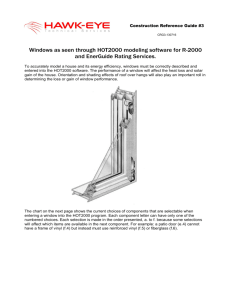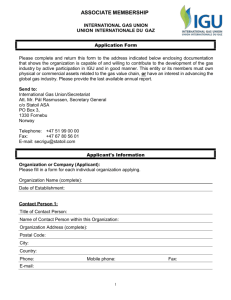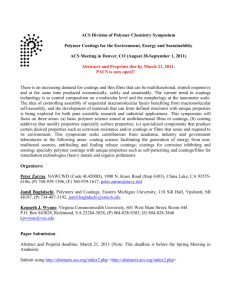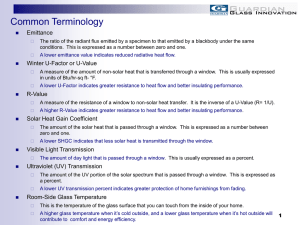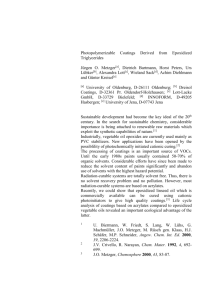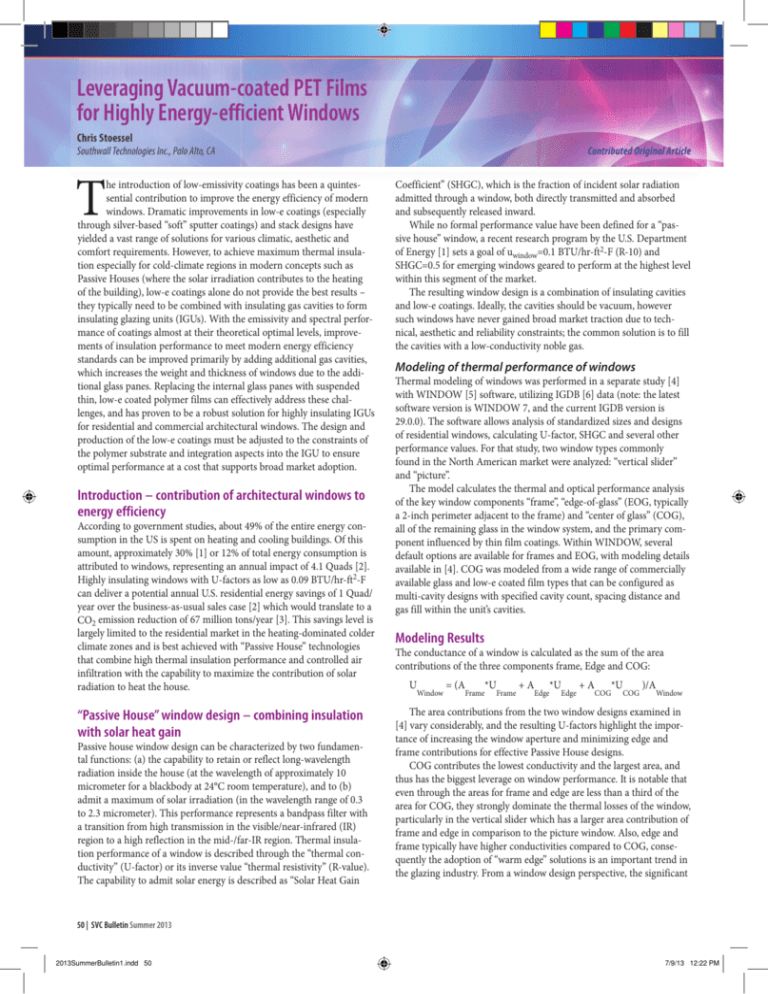
Leveraging Vacuum-coated PET Films
for Highly Energy-efficient Windows
Chris Stoessel
Contributed Original Article
Southwall Technologies Inc., Palo Alto, CA
T
he introduction of low-emissivity coatings has been a quintessential contribution to improve the energy efficiency of modern
windows. Dramatic improvements in low-e coatings (especially
through silver-based “soft” sputter coatings) and stack designs have
yielded a vast range of solutions for various climatic, aesthetic and
comfort requirements. However, to achieve maximum thermal insulation especially for cold-climate regions in modern concepts such as
Passive Houses (where the solar irradiation contributes to the heating
of the building), low-e coatings alone do not provide the best results –
they typically need to be combined with insulating gas cavities to form
insulating glazing units (IGUs). With the emissivity and spectral performance of coatings almost at their theoretical optimal levels, improvements of insulation performance to meet modern energy efficiency
standards can be improved primarily by adding additional gas cavities,
which increases the weight and thickness of windows due to the additional glass panes. Replacing the internal glass panes with suspended
thin, low-e coated polymer films can effectively address these challenges, and has proven to be a robust solution for highly insulating IGUs
for residential and commercial architectural windows. The design and
production of the low-e coatings must be adjusted to the constraints of
the polymer substrate and integration aspects into the IGU to ensure
optimal performance at a cost that supports broad market adoption.
Introduction – contribution of architectural windows to
energy efficiency
According to government studies, about 49% of the entire energy consumption in the US is spent on heating and cooling buildings. Of this
amount, approximately 30% [1] or 12% of total energy consumption is
attributed to windows, representing an annual impact of 4.1 Quads [2].
Highly insulating windows with U-factors as low as 0.09 BTU/hr-ft2-F
can deliver a potential annual U.S. residential energy savings of 1 Quad/
year over the business-as-usual sales case [2] which would translate to a
CO2 emission reduction of 67 million tons/year [3]. This savings level is
largely limited to the residential market in the heating-dominated colder
climate zones and is best achieved with “Passive House” technologies
that combine high thermal insulation performance and controlled air
infiltration with the capability to maximize the contribution of solar
radiation to heat the house.
“Passive House” window design – combining insulation
with solar heat gain
Passive house window design can be characterized by two fundamental functions: (a) the capability to retain or reflect long-wavelength
radiation inside the house (at the wavelength of approximately 10
micrometer for a blackbody at 24°C room temperature), and to (b)
admit a maximum of solar irradiation (in the wavelength range of 0.3
to 2.3 micrometer). This performance represents a bandpass filter with
a ­transition from high transmission in the visible/near-infrared (IR)
region to a high reflection in the mid-/far-IR region. Thermal insulation performance of a window is described through the “thermal conductivity” (U-factor) or its inverse value “thermal resistivity” (R-value).
The capability to admit solar energy is described as “Solar Heat Gain
Coefficient” (SHGC), which is the fraction of incident solar radiation
admitted through a window, both directly transmitted and absorbed
and subsequently released inward.
While no formal performance value have been defined for a “passive house” window, a recent research program by the U.S. Department
of Energy [1] sets a goal of uwindow=0.1 BTU/hr-ft2-F (R-10) and
SHGC=0.5 for emerging windows geared to perform at the highest level
within this segment of the market.
The resulting window design is a combination of insulating cavities
and low-e coatings. Ideally, the cavities should be vacuum, however
such windows have never gained broad market traction due to technical, aesthetic and reliability constraints; the common solution is to fill
the cavities with a low-conductivity noble gas.
Modeling of thermal performance of windows
Thermal modeling of windows was performed in a separate study [4]
with WINDOW [5] software, utilizing IGDB [6] data (note: the l­atest
software version is WINDOW 7, and the current IGDB version is
29.0.0). The software allows analysis of standardized sizes and designs
of residential windows, calculating U-factor, SHGC and several other
performance values. For that study, two window types commonly
found in the North American market were analyzed: “vertical slider”
and “picture”.
The model calculates the thermal and optical performance analysis
of the key window components “frame”, “edge-of-glass” (EOG, typically
a 2-inch perimeter adjacent to the frame) and “center of glass” (COG),
all of the remaining glass in the window system, and the primary component influenced by thin film coatings. Within WINDOW, several
default options are available for frames and EOG, with modeling details
available in [4]. COG was modeled from a wide range of commercially
available glass and low-e coated film types that can be configured as
multi-cavity designs with specified cavity count, spacing distance and
gas fill within the unit’s cavities.
Modeling Results
The conductance of a window is calculated as the sum of the area
­contributions of the three components frame, Edge and COG:
U
Window
= (A
*U
Frame
Frame
+A
*U
Edge
Edge
+A
*U
COG
COG
)/A
Window
The area contributions from the two window designs examined in
[4] vary considerably, and the resulting U-factors highlight the importance of increasing the window aperture and minimizing edge and
frame contributions for effective Passive House designs.
COG contributes the lowest conductivity and the largest area, and
thus has the biggest leverage on window performance. It is notable that
even through the areas for frame and edge are less than a third of the
area for COG, they strongly dominate the thermal losses of the window,
particularly in the vertical slider which has a larger area contribution of
frame and edge in comparison to the picture window. Also, edge and
frame typically have higher conductivities compared to COG, consequently the adoption of “warm edge” solutions is an important trend in
the glazing industry. From a window design perspective, the significant
50 | SVC Bulletin Summer 2013
2013SummerBulletin1.indd 50
7/9/13 12:22 PM
Fig. 5: Insulation Performance of several IGU designs vs. Pocket Width
thermal losses incurred from the window frames call for minimizing
their cross-section in a window, which can be achieved by reducing the
structural load on the frames through light-weight IGUs with optimized
overall thickness.
COG performance is determined by the design of the IGU. Design
variables are the thickness and type of glass, type and location of low-e
coatings, number of cavities (in multi-pane IGUs), the overall thickness
(OAT, or “Pocket Width” in the frame) which determines the width of
the cavity, and the gas filling within the cavities.
Figure 1 summarizes the effect of various design variations on the
thermal performance (U-factor) and SHGC of an IGU. For reference, a
single-pane window typically has a UCOG=0.93 BTU/hr-ft2-F. Filling a
non-low-e dual-pane (single-cavity) IGU with Krypton gas achieves a
UCOG=0.445 BTU/hr-ft2-F. Krypton filling an IG represents the highest
“commercially viable” performance for a single cavity IGU without a
low-e coating. Krypton is the best-performing fill gas commonly used
in the glazing industry, but its cost is a factor of approximately 500
times higher than that of argon, and thus can not be considered for
large-scale low-cost glazing solutions. Therefore, Argon-filled IGUs are
the de-facto standard for high-performance mass-market IGUs.
Adding a low-e coating (in this case and as an example, a modern
sputtered high-SHGC-capable single-silver “LoE-180™” softcoat produced by Cardinal Glass Industries, and denoted as “180” in the figures)
to the single-cavity IGU (filled with industry-typical argon/air mixture
of 90/10 vol%) improves the UCOG to approx 0.26 BTU/hr-ft2-F. Note
that there is an optimum cavity width (in this case for an OAT of 0.69”)
that is largely determined by the conductive thermal and fluid properties of the fill gas.
1-Cav (CLR-CLR) Air
1-Cav (CLR-CLR) Ar/Air90/10
1-Cav (CLR-CLR) Kr
1-Cav (180-CLR)
2-Cav (180-180-CLR)
2-Cav Heat Mirror (180-88-CLR)
3-Cav Heat Mirror (180-88-88-CLR)
4-Cav Heat Mirror (180-88-88-88-CLR)
3-Cav (366-CLR-CLR-CLR)
0.50
0.45
2
UCOG [BTU/hr-ft -F]
Center of Glass (COG)
0.55
0.40
0.35
0.30
0.25
0.20
0.15
0.10
0.05
0.63
0.75
0.88
1.00
1.13
1.25
1.38
1.50
1.63
1.75
1.88
2.00
2.13
OAT (inch)
Figure 1: Insulation Performance of several IGU designs vs. Pocket Width
A further improvement towards an R-10 window of conventional
design (low-e coated glass with argon fill) can be achieved through
adding one or two cavities and widening the IGU to accommodate sufficient cavity width. Dual-cavity design achieves an optimum of approx
UCOG=0.13 BTU/hr-ft2-F. Two variations are shown, one is an all-glass
(triple pane) construction with a low-e coating per cavity, the other
is a variation with a suspended low-e-coated polyester terephthalate
(PET) polymer film (in this case and as an example, Heat Mirror 88
produced by Southwall Technologies, denoted as “88” in the figures),
which reduces IGU weight and OAT by replacing the center glass. The
glass-based solution shows an advantage in the U-factor/SHGC balance,
indicating the optimized silver quality that can be achieved on glass
continued on page 52
Summer 2013 SVC Bulletin | 51
2013SummerBulletin1.indd 51
7/9/13 12:22 PM
Leveraging vacuum-coated PET films
continued from page 51
substrates as compared to polymer substrates. Performance exceeding
UCOG=0.1 BTU/hr-ft2-F can only be achieved with three or more cavities and an OAT of greater than 1.75”. Such windows (and especially
patio doors) are very challenging to build, install and use with all-glass
construction due to the significant weight increase of the additional
glass, whereas separating the cavities with low-e coated polymer films
effectively eliminates any increase in weight and allows for narrower
overall OAT. Improvements from adding additional cavities (beyond 3)
are modest especially for OAT dimensions less than 2”, mostly because
the cavities can not be made sufficiently wide to optimize the fill gas’s
thermal transfer characteristics. Adding more cavities will also reduce
the SHGC (due to the transmission losses of added glass/film and coatings), which is already below 0.5 for a 3-cavity IGU with low-e coatings
in each cavity. Hence, three cavities, with four glazing layers, represents
a potential “sweet spot”, with significantly improved thermal performance, while maintaining acceptable levels of solar gain (SHGC).
The selection of low-e coatings from the broad range of available
options is important to maximize the performance of a “passive house”
window. Figure 1 includes a comparison of replacing three low-E singlesilver coatings of a three-cavity unit with a single “LoE366 ” (triplesilver low-E glass produced by Cardinal Glass, denoted as “366” in the
figure) on the outermost (cold) glass. Such a design might be desirable,
as it reduces the amount of sensitive low-e-coated glass required to
build a multi-cavity IGU. Although the two configurations contain
­approximately the same amount of silver for the low-e functionality, the
single-coating option is significantly less effective, and also reduces the
SHGC significantly, and thus is not a successful approach for a passivehouse window.
The take-away from Figure 1 is a design concept for Passive House
windows that must effectively incorporate multiple cavities combined
with a high-efficiency (soft-coat) sputtered single-silver low-e coatings
in each cavity. The width of the cavities can be improved through the
use of thin polymer films especially if the overall thickness of the IGU
is constrained. The incorporation of suspended polymer films also
­supports a lower overall IGU weight.
have yielded soft-coat low-e coatings on PET with emissivity below 0.1
that can be exposed to the environment (in this case the inside of the
window) in the form of applied window films [11].
Aesthetics: Reflected Color
Architects and homeowners are often concerned about the appearance
of glass, primarily their reflected color. Here, the reflected color appearance is not only a result of the outermost surface but a composite of the
reflections and transmitted optics throughout the entire IGU package.
Undesirable variations in color are often caused by replacing windows
with different low-e coatings, or variations in IGU design (cavity count,
shading) within the same façade. Figure 2 shows the shift of reflected
color (at normal incidence) in the Ra*/Rb* coordinate space (of the
La*b* color system), starting from the slight green color of standard
float glass. Additional low-e coatings and cavities move the reflected
color further towards blue (and green in the case of all-loE180-coated
glass). While not shown here (and difficult to model without detailed
knowledge of the low-e coating stacks), color variations can be even
more pronounced
angles.
Fig.at
6: non-normal
Reflected Colorviewing
for various
glazing designs
-3
TM
High-efficiency soft-coat low-e coatings
COG performance is highly dependent on the quality of the low-e
coating. Most modern high-performance low-e coatings for glazing
applications rely on silver as the infrared-reflecting filter element, and
the quality of the silver film is characterized by achieving low emissivity
at the highest possible visible or solar transmission. The best-performing silver films are sputter-coated on smooth substrates to suppress
absorption-inducing plasmon resonance interference effects [8]. Also,
it has been shown that special seed layers that achieve a homogeneous
and fine grain structure improve the performance of low-e coatings [9].
From a web coater equipment and process control perspective, the bestperforming silver films are deposited in process conditions that inhibit
detrimental silver oxidation [10] by ensuring good gas separation from
adjacent reactive sputter processes that deposit the dielectric layers.
When applied in IGUs, silver-based low-e coatings are generally
located inside the gas-filled and desiccated IGU cavities, and are thus
well-protected from deleterious environmental influences that would
otherwise lead to tarnishing of the silver layers. This enables multidecade service life and has been demonstrated regardless whether the
substrate is glass or a polymer, without the use of protective barrier
coatings, as long as the IGU seal stays intact.
While most high-performance low-e coatings are intended for use
within the IGU (or embedding into a laminate), recent developments
-2.5
-2
-1.5
0
CLR-CLR
-1
-0.5
0
0.5
-2
low-e
Rb*
-4
2-cavity
(Glass)
180-CLR
180-180-CLR
-6
2-cavity
(Heat
180-88-CLR
3-cavity
-8
180-88-88-CLR
-10
Ra*
Figure 2: Reflected Color for various glazing designs
The optics of a low-e coating are determined by the thickness and
index of refraction of the dielectric and silver layers. The color of the
substrate (glass or polymer) also influences the aesthetic characteristics.
Integrating PET-based low-e coatings into an IGU can maintain a more
neutral color (due to the inherent color of the PET and its thinner
cross-section) compared to typical low-e coated soda-lime float glass.
Other Improvements in low-e web coatings
for IGU integration
In order to expand the design variations for IGUs, low-e coatings can
be coated on both sides. This allows different glazing combinations to
­satisfy the “one low-e coating per cavity” design guideline. Also, low-e
coated PET films with lower Tsol or Tvis performance can be used to
increase shading or reduce glare (and consequently a diminishedSHGC). And similar to dual-silver low-e coated glass, multi-silver
low-e stacks are available on PET films. These products improve solar
­selectivity, i.e. they improve the “bandpass” function at the transition
between the visible (high transmission) and near-infrared (high reflection) spectrum.
Cost reduction is another ever-present goal particularly to support
broad adoption of energy-efficient windows, and low-e films can benefit
from the same trends seen elsewhere in the glazing industry: ways to
mitigate the dependence on relatively costly indium for dielectric oxide
layers (by substituting it with zinc and/or tin), fine-tuning the coating
stack and process parameters to improve silver quality and minimize
silver thickness. Cost reductions in the PET substrate are also sought,
52 | SVC Bulletin Summer 2013
2013SummerBulletin1.indd 52
7/9/13 12:22 PM
.1
ce
arthe
e.
ws
nt,
d
d
d
0.5
although many low-cost PET film alternatives have inferior optical and
process performance that prevent market acceptance. Thinner PET
film substrates require improved thermal and web handling control to
suppress heat creases during sputter coating deposition and wrinkling
damage during subsequent winding and slitting operations, and also
pose a challenge for the IGU assembly process to avoid creasing and
wrinkling, requiring special care during film application.
Conclusions
The performance of an economical passive house window with low
U-factor and high SHGC can be achieved with argon-filled triple-cavity
IGUs with a single-silver low-e coating facing each cavity. The thermal
performance of COG is significantly higher than that of the frame and
edge-of-glass, and thus a passive house window benefits from the largest possible glass area. To keep window frames thin, the IGU structure
needs to be as light-weight and compact as possible, favoring multicavity designs that replace center glass panes with suspended low-e
coated polymer films. In the design of low-e coatings, it is essential to
optimize the efficiency of the silver layer through improved deposition
processes in order to achieve the optimum balance between thermal
insulation performance and SHGC. From an optical design perspective,
a stack design that maintains a neutral color irrespective of cavity count
is desirable. Market adoption of advanced energy-efficient coatings is
supported by cost-reduction efforts in the coating stack as well as the
PET substrate.
About the Author
Chris Stoessel
Chris H. Stoessel is a Senior Process Development Manager at Eastman Chemical
Co.’s Palo Alto Advanced Technology Center (Southwall Technologies Inc.) in
Palo Alto, California. He holds a Ph.D. in
Mechanical Engineering (Materials Science)
from the Rheinische Westfälische Technische
Hochschule Aachen (Germany), and conducted
post-doctoral studies under Rointan Bunshah
at UCLA. He has developed thin-film products
and deposition processes for a wide range of
applications such as tribology (via sputtering
and cathodic arc deposition), superconducting
films, optical coatings (at OCLI/JDS-Uniphase),
MEMS, OLED (at DuPont Displays), and
energy-efficient glazing (at Southwall
Technologies/Eastman Chemical Co.).
Chris contributes to the SVC as a co-chair of
SVC’s “Emerging” and “WebTech” TACs, serves
on the Board of Directors, and is Assistant
Program Chair for the 2013 and 2014 SVC TechCons.
For further information, contact Chris Stoessel, Southwall Technologies Inc.,
Palo Alto, CA, at cstoessel@southwall.com
Note: this article is adapted from a 2012 SVC TechCon contribution by
L. Boman, J. Meade, C. Stoessel, R. Wipfler: “Impact of Thin Film Coatings on the
Performance of Highly Energy-Efficient Windows”
Acknowledgments
This research was supported in part by the U.S. Department of Energy
grant DE-EE0003925.
LR
.
n
o
e
r
2. D. Arasteh, S. Selkowitz, J. Apte, and M. LaFrance. 2006. “Zero Energy Windows.”
Proc. 2006 ACEEE Summer Study on Energy Efficiency in Buildings, Pacific Grove, CA
(LBNL 60049)
WITH RF & DC SPUTTERING CAPABILITIES
3. Annual Energy Review 2007, DOE/EIA-0384 (2007), Washington, DC (June 2008)
4. L. Boman, J. Meade, C. Stoessel, R. Wipfler: “Impact of Thin Film Coatings on the
Performance of Highly Energy-Efficient Windows,” 54th Annual Technical Conference
Proceedings of the Society of Vacuum Coaters, p. 452, 2011
5. Lawrence Berkeley National Laboratory: WINDOW 6.3.9.0 (http://windows.lbl.gov/
software/window/6/index.html)
6. Lawrence Berkeley National Laboratory: International Glazing Database 18.0
(http://windows.lbl.gov/materials/IGDB/default.htm)
7. Datasheet published by Bundesverband Flachglas / GMI
8. Y. Tachibana, K. Kusunoki, H. Ohsaki: “Optical properties of Ag/dielectric-material
multilayers”, J. Vacuum, 74 (3-4), pp 555-559, 2004
9. K. Fukuda, S. H.N. Lim, A. Anders: “Coalescence of magnetron-sputtered silver islands
affected by transition metal seeding (Ni, Cr, Nb, Zr, Mo, W, Ta) and other parameters”,
Thin Solid Films, 516 (14), pp. 4546-4552, 2008
10. H. Sahm, C. Charton, R. Thielsch: “Oxidation behaviour of thin silver films deposited
on plastic web characterized by spectroscopic ellipsometry (SE)”, Thin Solid Films,
455-456, pp. 819-823, 2004
11. J.A. Li: “Retro-Fit Low Emissivity Window Films,” 56th Annual Technical Conference
Proceedings of the Society of Vacuum Coaters, 2013 in preparation
c-
STANDARD FEATURES:
Table Top Sputtering System
(20” x 24“ Footprint)
Polished Stainless Steel Chamber
Full Front Door Opening with
View Port
Quartz Crystal Thickness Monitor
Turbomolecular Pumping System
with Matching Dual Stage Rotary
Vane Pump
Full Range Vacuum Gauge
Two 2” Magnetron Sputter Guns
300W RF 13.56 MHz Power Supply
with Automatic Matching Network
600W DC Power Supply
Mass Flow Controllers
115 mm Sample Stage
OPTIONAL FEATURES:
3” Magnetron Sputter Gun
600W RF Power Supply
1200W DC Power Supply
Substrate Rotation
Substrate Heating
RF Biasing
RF Cleaning
Dry Scroll Pump
Water Chiller (Closed Loop Design)
rt
nefit
de
g
Email: torr@ torr.com
www.torr.com
(845) 565-4027
(888) MAC-TORR
Fax: (845) 561-7731
12 Columbus Street; New Windsor, NY 12553
,
1989 - 2011 TORR INTERNATIONAL, INC. ALL RIGHTS RESERVED
ics.
ore
1. Department of Energy, “Recovery Act: Advanced Energy Efficient Building
Technologies”, FOA#: DE-FOA-0000115, 06/29/2009
C
d
References
Summer 2013 SVC Bulletin | 53
2013SummerBulletin1.indd 53
7/9/13 12:22 PM

